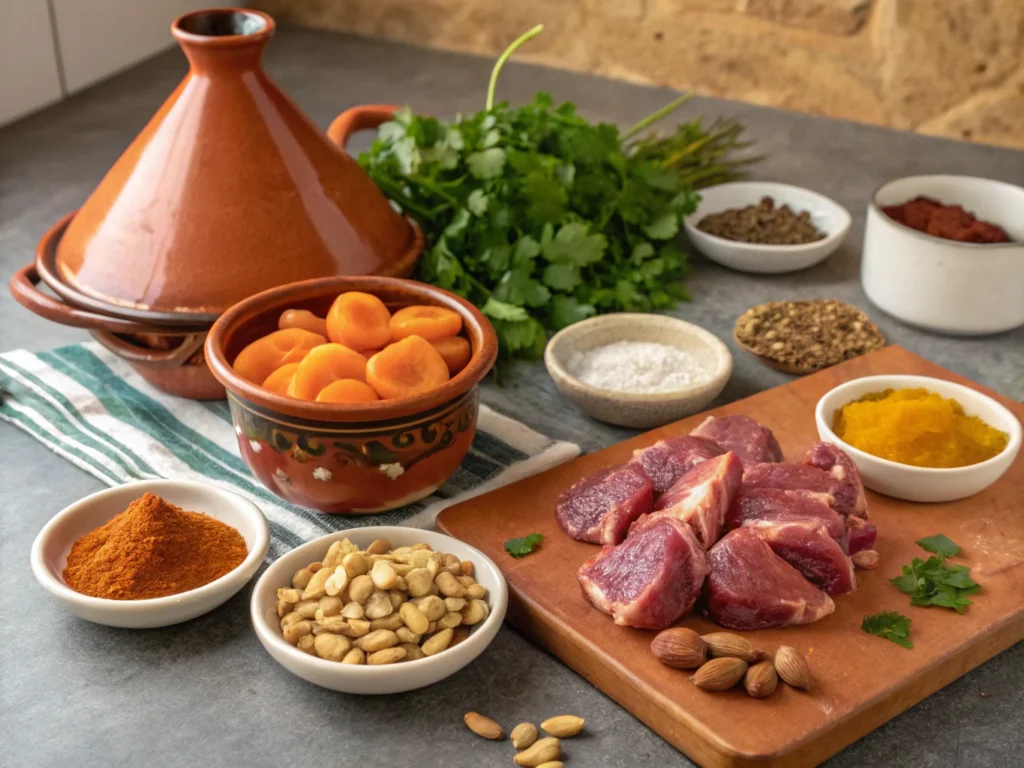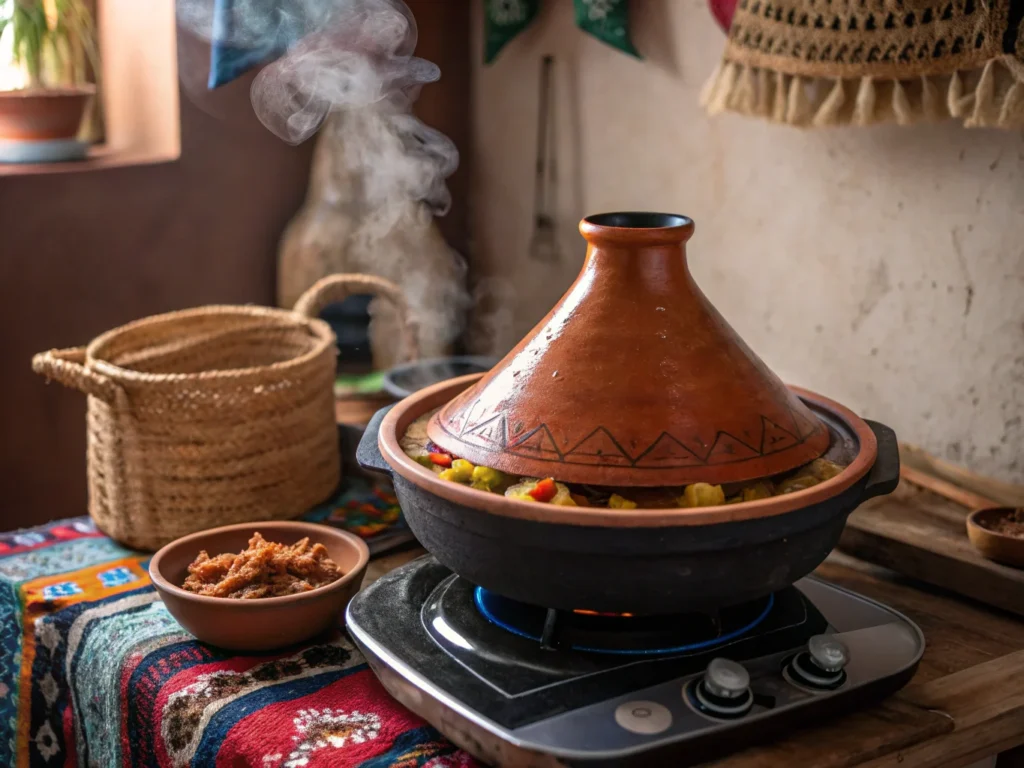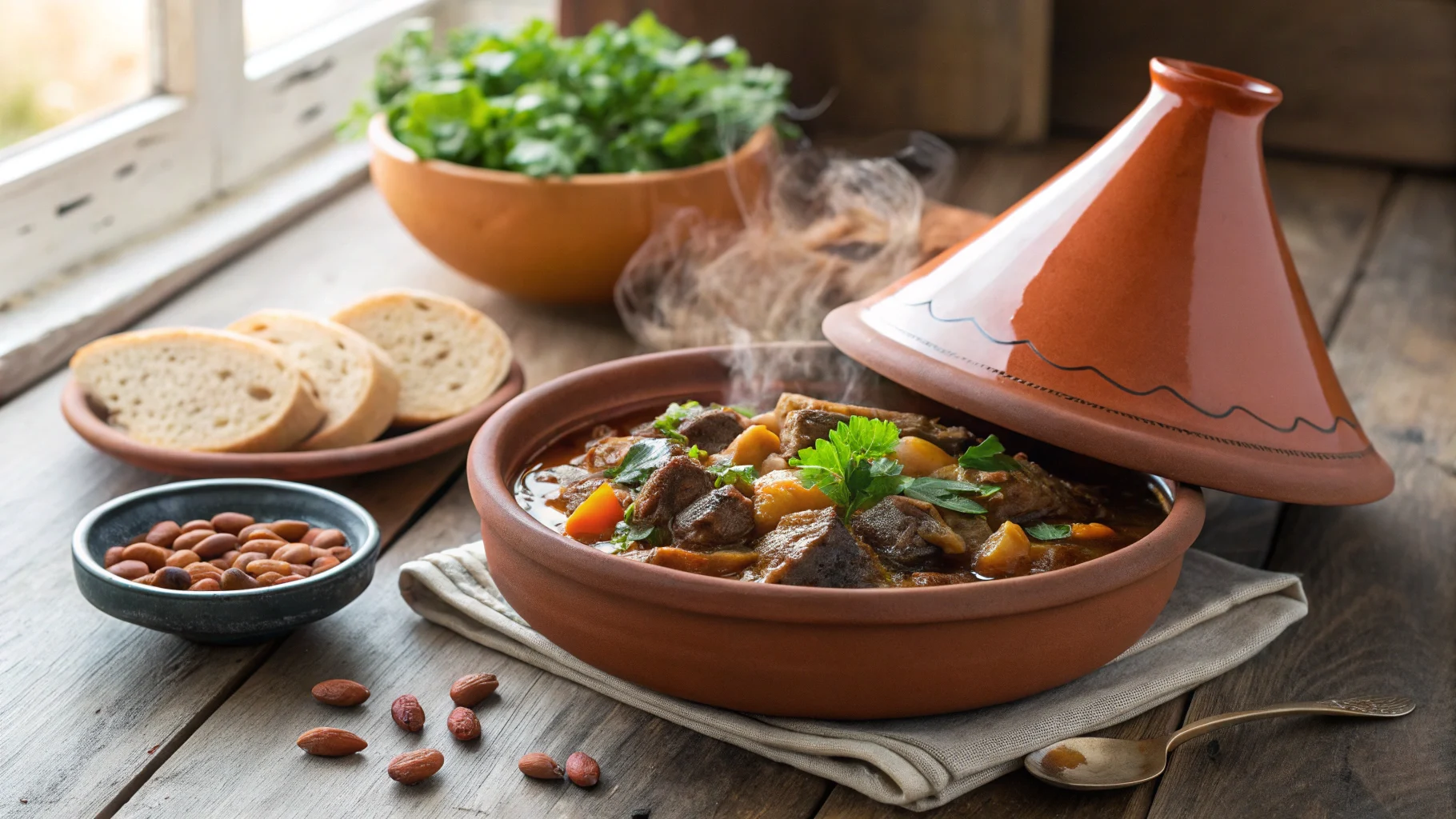A tagine is not just a fancy cooking vessel—it’s a key element in creating flavorful stews and braises, especially in Moroccan cuisine. If you’ve ever wandered through a Moroccan market or scrolled Pinterest for dinner inspo, you’ve likely seen those stunning clay pots with pointy lids. But what are they made of, and why do people swear by them? Sit tight, foodies—we’re about to break it all down!
Table of contents
What Is a Tagine Made Of?
First, let’s clear up the confusion: a tagine refers to both the dish and the pot. (Yeah, it’s a two-in-one situation.) The tagine pot is a slow-cooking powerhouse used to make stews and braises packed with spices, meat, veggies, and sometimes dried fruit. Think of it as the OG slow cooker—minus the electricity.
But here’s the real magic: the unique shape of the pot. That tall, cone-shaped lid? It traps steam as the food cooks, letting all those rich, flavorful juices drip back down into the dish. It’s like nature’s baster, doing the hard work for you.
Traditional Tagine: Materials and Design
Let’s dig into the juicy details (because yes, this matters). So, what is a tagine made of when it comes to materials? Tagines come in a few different materials, each with its own pros and cons. Here’s a breakdown:
1. Clay Tagine Pots
Most traditional tagines are made of clay. Why? Because clay is super good at retaining heat and spreading it evenly. These are the most traditional and commonly used. Unglazed clay adds an earthy flavor to dishes like Tagine Rabbit Recipe, making it a go-to for authentic Moroccan cooking.
- Unglazed Clay:
These are the OGs of tagine pots. Unglazed clay is porous, so it absorbs some of the flavors while you cook, creating a natural seasoning over time. (Kind of like cast iron but way cooler, if you ask me.)
Pro tip: You’ll need to soak unglazed clay tagines in water before using them for the first time to prevent cracking. - Glazed Clay:
These are easier to clean and maintain because they’ve got a shiny finish that seals the surface. They might not develop that deep, seasoned flavor over time, but hey, they’re great for beginners.
2. Ceramic Tagine Pots
Ceramic tagines are like the trendy cousin of clay tagines. They’re colorful, durable, and can handle a bit more heat. If you’ve got one of those bougie modern kitchens, a ceramic tagine will probably fit right in.
Fun fact: Ceramic tagines are often hand-painted with intricate designs. They look so good, you’ll probably want to leave them out on your counter just for the aesthetics.
3. Cast Iron Tagines
Yes, cast iron tagines are a thing. These bad boys are lined with enamel (so they don’t rust) and are perfect for cooks who like modern conveniences. They work on all stovetops—including induction—and don’t need the extra TLC that clay does.
But here’s the catch: they’re heavy. Like, “don’t drop this on your foot” heavy.
4. Metal Tagines
Okay, so metal tagines aren’t as common, but they’re still out there. They’re lightweight, durable, and often used for decorative purposes. If you’re hosting a Moroccan-themed dinner party, a metal tagine might make a cool centerpiece.

Key Ingredients in a Tagine Dish
Alright, now let’s talk food—the part we’re all really here for. A tagine dish is more than just a stew; it’s an explosion of flavors, textures, and aromas. The ingredients can vary depending on the recipe, but here’s a rundown of the key players you’ll usually find:
1. Meat or Protein for Tagine Dishes
Traditional tagines often feature chicken, lamb, or beef. The slow-cooking method makes the meat fall-off-the-bone tender. If you’re vegetarian, chickpeas or lentils are a great swap—they soak up all those spices like a dream.
2. Vegetables in a Tagine
Potatoes, carrots, zucchini, and tomatoes are common choices. They not only add bulk but also help balance out the richness of the dish. Bonus: the long cooking time makes veggies taste ridiculously good.
3. Spices for Moroccan Tagine
This is where the magic happens. Spices like cumin, turmeric, paprika, and cinnamon create those warm, comforting flavors Moroccan food is known for. And don’t forget saffron—it’s a game-changer. similar to tips mentioned in How to Fix Taco Soup Too Spicy.
4. Dried Fruits and Nuts for Tagine Recipes
Dried apricots, dates, or raisins bring a touch of sweetness to the dish, making it taste complex and balanced. Trust me, even if you’re not a “sweet with savory” person, you’ll love this combo.
5. Nuts
Almonds or pine nuts are often sprinkled on top for a bit of crunch. It’s that final flourish that takes your dish from good to wow.
5. Herbs and Liquid in a Tagine
Fresh parsley or cilantro is a must for that bright, fresh finish. Sprinkle it on just before serving to really make the flavors pop.
7. Liquid
Every tagine needs a bit of liquid—broth, water, or even a splash of wine—to create the steam that makes the dish so tender and saucy. The cone-shaped lid traps it all inside, so nothing goes to waste.

How Are Traditional Tagine Pots Crafted?
Now that we know the materials, let’s talk about the process. When making a tagine, what is it crafted from? Traditional tagines are handcrafted by artisans, often in Morocco. Here’s how it usually goes:
- Shaping the Clay
First, artisans mold the clay by hand or on a pottery wheel. This step takes serious skill because the cone-shaped lid has to fit perfectly on the base—no wobbly tops allowed! - Drying
After shaping, the clay needs to dry for a few days. Think of this like letting dough rise—it’s all about patience. - Firing
The dried clay is fired in a kiln at super-high temperatures to harden it. For glazed tagines, this step happens twice: once to harden the clay and again after the glaze is applied. - Painting and Glazing
For ceramic and glazed clay tagines, this is where the magic happens. Artists hand-paint the pots with vibrant patterns, giving each one a unique look.
Why the Material of a Tagine Matters for Cooking
Now, you might be wondering: does it really make a difference what my tagine is made of? Short answer: yes. Long answer? Let’s break it down.
Heat Retention
Clay and ceramic tagines are champs at holding heat, making them perfect for slow-cooking. Cast iron is great too, but it heats up faster—so you might need to adjust your cooking times.
Flavor
Unglazed clay adds an earthy, smoky flavor to your food, which is kind of the whole point of using a traditional tagine. Glazed tagines and other materials won’t have that same effect, but they’re still great for cooking.
Maintenance
Let’s be real: not everyone wants to babysit their cookware. If you’re the “set it and forget it” type, cast iron or glazed ceramic might be more your speed.
For recipes like Southern Cornbread Recipe, pairing it with a Moroccan stew can create a comforting meal.
Can You Cook with a Decorative Tagine?
So, you bought a gorgeous tagine at a flea market. Can you actually cook with it? Well, maybe. Some tagines are purely decorative, especially those made of lightweight metal or painted with non-food-safe glazes. Always check before you fire it up.

Where to Buy a Tagine Pot
If you’re ready to jump on the tagine train, you’ve got options. Many stores in the U.S. carry tagines these days, from specialty kitchen shops to online retailers like Amazon. For a more authentic vibe, try ordering directly from Moroccan artisans. It might take a little longer to arrive, but trust me—it’s worth it.
FAQs
What is the best material for a tagine?
The best material for a tagine is unglazed clay or ceramic. These materials offer excellent heat retention and moisture circulation, which are key to the dish’s signature slow-cooking technique. Additionally, unglazed clay helps impart a slightly earthy flavor to the food.
How is a tagine different from a Dutch oven?
While both a tagine and a Dutch oven are used for slow cooking, they differ in their shape, material, and cooking technique:
Shape: A tagine has a conical lid that facilitates moisture circulation, while a Dutch oven typically has a flat lid.
Material: Tagines are often made of clay or ceramic, which retain heat effectively, whereas Dutch ovens are commonly made from cast iron.
Cooking Method: Tagines are often used for stovetop or oven cooking and rely on a gentle simmer, while Dutch ovens can be used for both stovetop and oven cooking and are typically more versatile for high-heat searing and braising.
What is special about a tagine?
The special feature of a tagine is its unique design and the way it retains heat. The conical lid allows moisture to circulate and return to the food, enhancing the flavors while preventing the dish from drying out. This makes it ideal for slow-cooked stews and braises. The tagine’s shape also allows for better distribution of heat, ensuring even cooking of the ingredients.
What is a traditional tagine made of?
A traditional tagine is typically made from clay or ceramic. The material is essential for its slow-cooking ability, as it retains heat and moisture, allowing food to simmer and develop rich flavors. The base of the tagine is flat, and it features a distinctive conical lid that helps condense and return steam to the dish, keeping the food tender and flavorful.
Final Thoughts
So, what is a tagine made of? The answer isn’t just clay or ceramic or cast iron—it’s tradition, culture, and a whole lot of love. Whether you’re a seasoned chef or a total newbie, a tagine can take your cooking game to the next level. And hey, if nothing else, it’ll make your kitchen look really, really cool.
Looking to get started? Explore our Tagine Rabbit Recipe or pair your tagine dish with the Southern Cornbread Recipe for a unique twist.
Got questions about tagines? Drop them in the comments below—I’d love to hear from you!

